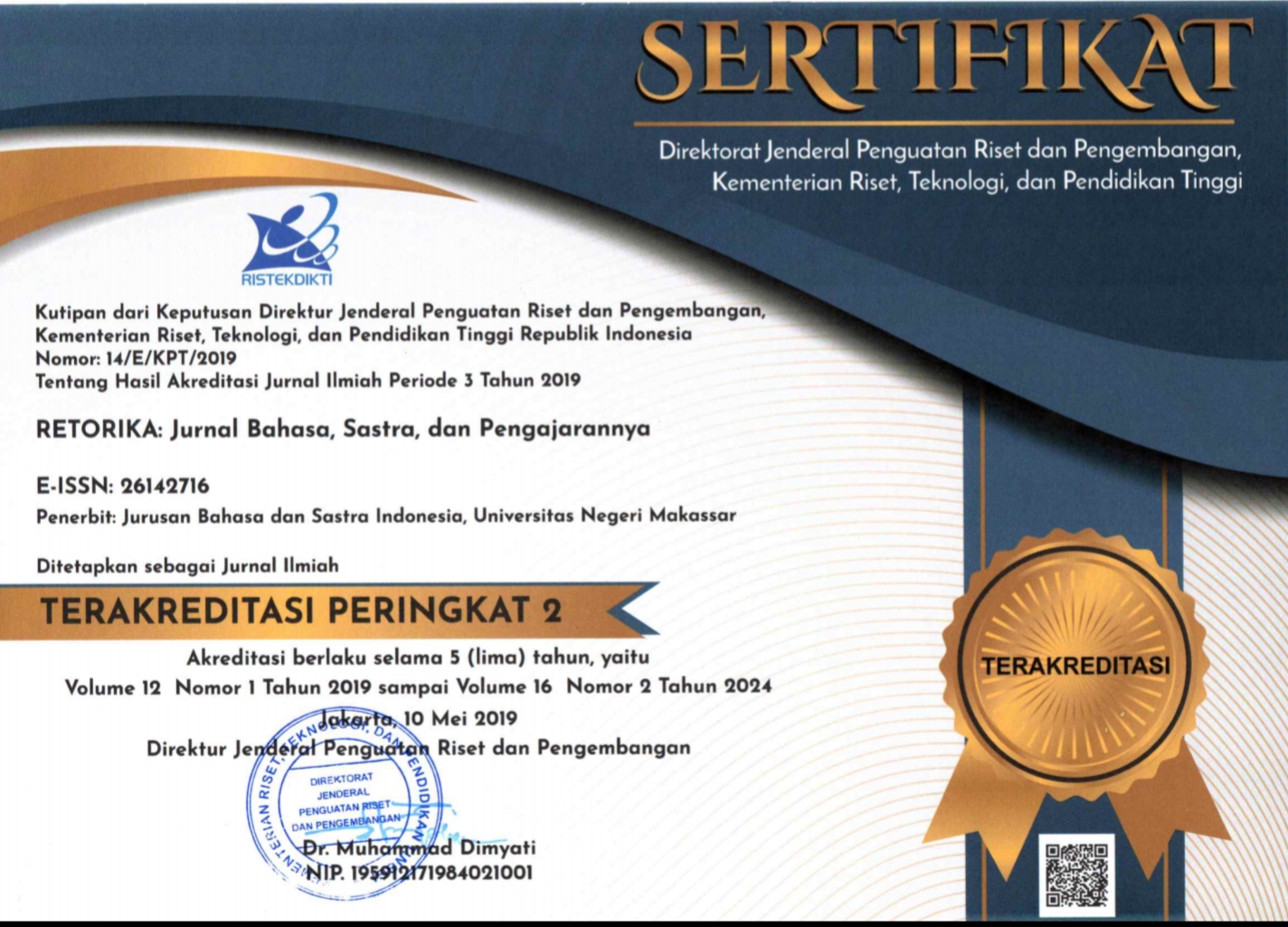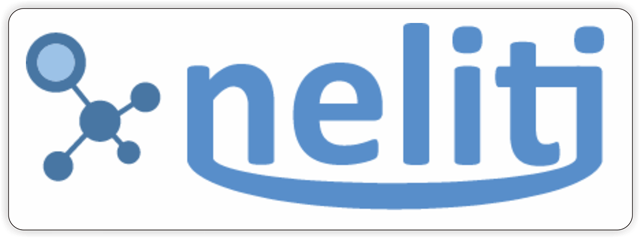FOREIGN VERSUS INDONESIAN AND LOCAL LANGUANGES IN IDENTITY OF BUSINESS ENTITY’S NAME IN SOSROWIJAYAN TOURISM VILLAGE YOGYAKARTA
(1) Universitas Gadjah Mada
(*) Corresponding Author
DOI: https://doi.org/10.26858/retorika.v15i2.30254
Abstract
The language used in business’ name in the Sosrowijayan tourism village is varied, including the inevitably use of foreign language. This study aims to examine the use of foreign language compared to Indonesian and regional languages in business’ name. The research questions whether the name used shows Javanese and Indonesian identity as a tourism area that represents Yogyakarta. The data is collected through satellite image in Google Maps and in-depth interview with the business’ owner. The names collected are classified according to its form related to the structure and the meaning of business’ name. After that, the data of the business’ name, which relates to its identity, is interpreted using social and cultural approach to understand the strategies used by the meaning of business’ name. The result of this study shows that business’ name as an identity has a purpose to target certain consumers and it is also adjusted to the owners’ identity who are culturally influenced by local, national and international environment.
Keywords
Full Text:
PDFReferences
Aribowo, E. K. (2017). Linking Arabic, Islam, and Economy: Onomastics on Business Name of People of Arab Descent in Indonesia. Karsa: Jurnal Sosial Dan Budaya Keislaman, 25(2), 284–306. https://doi.org/10.19105/karsa.v25i2.1390
Aribowo, E. K., & Herawati, N. (2016). Trends in Naming System on Javanese Society: A Shift From Javanese to Arabic. Lingua Cultura, 10(2), 117–122. https://doi.org/10.21512/lc.v10i2.1730
Astrea, K. (2017). Hipotesis Sapir-Whorf dalam Proses Toponimi Kabupaten Tuban (Kajian Antropologi Linguistik). BASTRA: Jurnal Penelitian Pendidikan Bahasa Dan Sastra, 4(1), 49–56. Retrieved from https://core.ac.uk/download/pdf/228862772.pdf
Blankson, C., Cowan, K., & Darley, W. K. (2018). Marketing Practices of Rural Micro and Small Businesses in Ghana: The Role of Public Policy. Journal of Macromarketing, 38(1), 29–56. https://doi.org/10.1177/0276146717741067
Cholsy, H. (2017). Kata Serapan dan Kosakata Bahasa Prancis dalam Ranah Kuliner dan Mode di Indonesia (Dissertasi, Universitas Gadjah Mada). Universitas Gadjah Mada, Yogyakarta. Retrieved from http://etd.repository.ugm.ac.id/penelitian/detail/111838
Cholsy, H., Wijana, I. D. P., Nadar, F. X., & Udasmoro, W. (2015). The status of French loanwords in the Indonesian language. Humaniora, 26(3), 303–314. https://doi.org/10.22146/jh.6189
Glǎveanu, V. P., & Tanggaard, L. (2014). Creativity, identity, and representation: Towards a socio-cultural theory of creative identity. New Ideas in Psychology, 34(1), 12–21. https://doi.org/10.1016/j.newideapsych.2014.02.002
Hasan, A., Dardjowidjojo, S., Lapoliwa, H., & Moeliono, A. (2000). Tata bahasa baku bahasa Indonesia. Jakarta: Balai Pustaka.
Kadmon, N. (2000). Toponymy: The lore, laws, and language of geographical names. New York: Vantage Press.
Kridalaksana, H. (1994). Kelas kata dalam bahasa Indonesia. Jakarta: Gramedia.
Kurniasih, N. (2019). Penggunaan Bahasa Asing dan Daerah pada Papan Nama Usaha dan Iklan (Studi Kasus di Banjarbaru dan Martapura). UNDAS: Jurnal Hasil Penelitian Bahasa dan Sastra, 14(1), 92–103. https://doi.org/10.26499/und.v14i1.1138
Nasution, L. Y., & Mulyadi, M. (2020). Market Names in Medan: A Natural Semantic Metalanguage Study. RETORIKA: Jurnal Bahasa, Sastra, dan Pengajarannya, 13(2). https://doi.org/10.26858/retorika.v13i2.11985
Nisa, A. F., & Haryanto, R. (2014). Kajian Keberadaan Wisata Belanja Malioboro Terhadap Pertumbuhan Jasa Akomodasi Di Jalan Sosrowijayan Dan Jalan Dagen. Teknik PWK (Perencanaan Wilayah Kota), 3(4), 933–948. Retrieved from https://ejournal3.undip.ac.id/index.php/pwk/article/view/6749
Nugraha, H. S., Ariyanti, F., & Wanto, D. (2017). Penerapan Branding pada UKM Makanan Ringan di Kabupaten Jepara. Jurnal Administrasi Bisnis, 6(1), 16–23. https://doi.org/10.14710/jab.v6i1.16602
Nurhayati, E. (2013). Strategi Pemertahanan Bahasa Jawa Di Provinsi Daerah Istimewa Yogyakarta. LITERA, 12(1). https://doi.org/10.21831/ltr.v12i01.1338
Olaoye, A. A. (2013). Languages in Contact, a Blessing or a Scourge? A Case Study of Yoruba Ethnography of Greetings. Theory and Practice in Language Studies, 3(4), 669–677. https://doi.org/10.4304/tpls.3.4.669-677
Prihadi, P. (2015). Struktur Bahasa Nama Pedusunan (Kampung) di Daerah Istimewa Yogyakarta: Kajian Antropolinguistik. LITERA, 14(2). https://doi.org/10.21831/ltr.v14i2.7206
Priyono, J. de B., Kusriatmi, & Pafrida, M. (2018). Produk Domestik Regional Bruto Provinsi Daerah Istimewa Yogyakarta Menurut Lapangan Usaha 2013-2017 (No. 34550.1802). Yogyakarta: Badan Pusat Statisik Provinis Daerah Istimewa Yogyakarta. Retrieved from Badan Pusat Statisik Provinis Daerah Istimewa Yogyakarta website: https://yogyakarta.bps.go.id/publication/2018/07/13/7daccd8de6f4ff259e78bfc1/produk-domestik-regional-bruto-provinsi-daerah-istimewa-yogyakarta-menurut-lapangan-usaha-2013-2017
Rais, J., Lauder, M., Sudjiman, P., & Ayatrohaedi. (2008). Toponimi Indonesia: Sejarah budaya Bangsa yang Panjang dari Permukiman Manusia & Tertib Administrasi. Jakarta: Pradnya Paramita.
Rooney, J. A. (1995). Branding: A trend for today and tomorrow. Journal of Product & Brand Management, 4(4), 48–55. https://doi.org/10.1108/10610429510097690
Setiawan, B. (2020). Rights to the city, tolerance, and the Javanese concepts of “Rukun” and “Tepo Sliro”: A portray from five kampungs in Yogyakarta. IOP Conference Series: Earth and Environmental Science, 402(1), 012005. https://doi.org/10.1088/1755-1315/402/1/012005
Setiowati, Y., & Setyorini, F. (2018). Service Extraction and Sentiment Analysis to Indicate Hotel Service Quality in Yogyakarta based on User Opinion. 2018 International Seminar on Research of Information Technology and Intelligent Systems (ISRITI), 427–432. https://doi.org/10.1109/ISRITI.2018.8864269
Sjöblom, P. (2016). Commercial Names. In C. Hough (Ed.), The Oxford Handbook of Names and Naming (pp. 1–15). Oxford: Oxford University Press. https://doi.org/10.1093/oxfordhb/9780199656431.013.56
Subiyantoro. (2014). Survival Strategies of The Javanese Language in New Caledonia. Humaniora, 26(1), 43–55. https://doi.org/10.22146/jh.4699
Vallejo, C., & Dooly, M. (2020). Plurilingualism and translanguaging: Emergent approaches and shared concerns. Introduction to the special issue. International Journal of Bilingual Education and Bilingualism, 23(1), 1–16. https://doi.org/10.1080/13670050.2019.1600469
Widodo, S. T. (2013). Konstruksi Nama Orang Jawa Studi Kasus Nama-Nama Modern Di Surakarta. Humaniora, 25(1), 82–91. https://doi.org/10.22146/jh.1815
Wijana, I. D. P. (2011). Berkenalan dengan linguistik. Yogyakarta: A.Com Advertising.
Wijana, I. D. P. (2014). Bahasa, Kekuasaan, Dan Resistansinya: Studi Tentang Nama-Nama Badan Usaha Di Daerah Istimewa Yogyakarta. Humaniora, 26(1), 56–64. https://doi.org/10.22146/jh.4700
Wijana, I. D. P. (2016). Bahasa Dan Etnisitas: Studi Tentang Nama-Nama Rumah Makan Padang. Linguistik Indonesia, 34(2), 195–206. https://doi.org/10.26499/li.v34i2.50
Article Metrics
Abstract view : 264 times | PDF view : 83 timesRefbacks
- There are currently no refbacks.
Copyright (c) 2023 Hayatul Cholsy

This work is licensed under a Creative Commons Attribution-NonCommercial 4.0 International License.
Published by:
Department of Indonesian Language, Faculty of Languages and Literature, Universitas Negeri Makassar in cooperate with Asosiasi Dosen Bahasa dan Sastra Indonesia (ADOBSI) and Ikatan Program Studi Pendidikan Bahasa dan Sastra Indonesia (IKAPROBSI).
Address: Department of Indonesian Language Office, DG Building Second Floor, UNM Parangtambung, Daeng Tata Raya Street, Makassar, South Sulawesi, Indonesia
 Email: retorika@unm.ac.id
Email: retorika@unm.ac.id

RETORIKA: Jurnal Bahasa, Sastra,dan Pengajarannya is licensed under a Creative Commons Attribution-NonCommercial 4.0 International License.
















